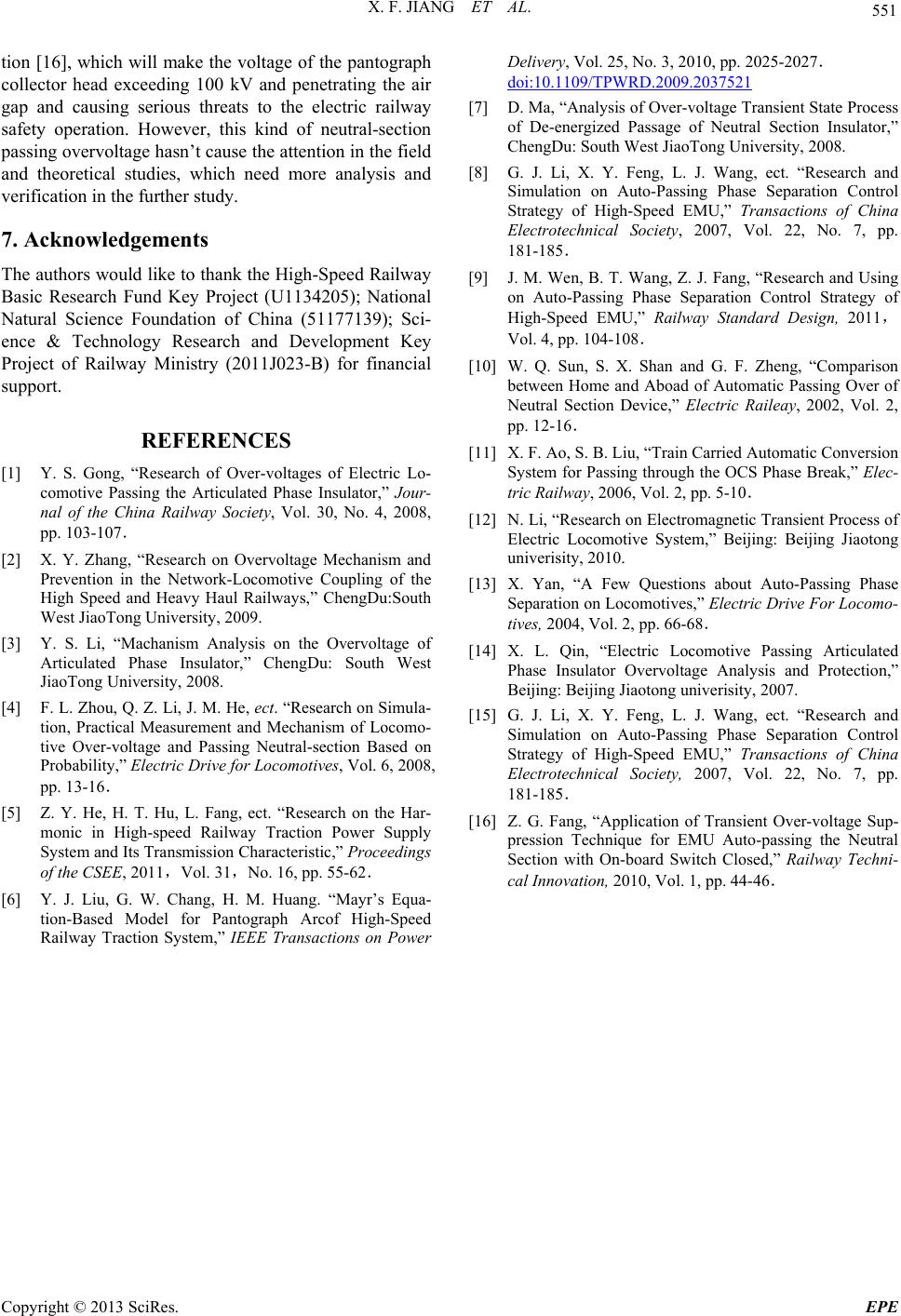
X. F. JIANG ET AL.
Copyright © 2013 SciRes. EPE
551
tion [16], which will make the voltage of the pantograph
collector head exceeding 100 kV and penetrating the air
gap and causing serious threats to the electric railway
safety operation. However, this kind of neutral-section
passing overvoltage hasn’t cause the attention in the field
and theoretical studies, which need more analysis and
verification in the further study.
7. Acknowledgements
The authors would like to thank the High-Speed Railway
Basic Research Fund Key Project (U1134205); National
Natural Science Foundation of China (51177139); Sci-
ence & Technology Research and Development Key
Project of Railway Ministry (2011J023-B) for financial
support.
REFERENCES
[1] Y. S. Gong, “Research of Over-voltages of Electric Lo-
comotive Passing the Articulated Phase Insulator,” Jour-
nal of the China Railway Society, Vol. 30, No. 4, 2008,
pp. 103-107.
[2] X. Y. Zhang, “Research on Overvoltage Mechanism and
Prevention in the Network-Locomotive Coupling of the
High Speed and Heavy Haul Railways,” ChengDu:South
West JiaoTong University, 2009.
[3] Y. S. Li, “Machanism Analysis on the Overvoltage of
Articulated Phase Insulator,” ChengDu: South West
JiaoTong University, 2008.
[4] F. L. Zhou, Q. Z. Li, J. M. He, ect. “Research on Simula-
tion, Practical Measurement and Mechanism of Locomo-
tive Over-voltage and Passing Neutral-section Based on
Probability,” Electric Drive for Locomotives, Vol. 6, 2008,
pp. 13-16.
[5] Z. Y. He, H. T. Hu, L. Fang, ect. “Research on the Har-
monic in High-speed Railway Traction Power Supply
System and Its Transmission Characteristic,” Proceedings
of the CSEE, 2011,Vol. 31,No. 16, pp. 55-62.
[6] Y. J. Liu, G. W. Chang, H. M. Huang. “Mayr’s Equa-
tion-Based Model for Pantograph Arcof High-Speed
Railway Traction System,” IEEE Transactions on Power
Delivery, Vol. 25, No. 3, 2010, pp. 2025-2027.
doi:10.1109/TPWRD.2009.2037521
[7] D. Ma, “Analysis of Over-voltage Transient State Process
of De-energized Passage of Neutral Section Insulator,”
ChengDu: South West JiaoTong University, 2008.
[8] G. J. Li, X. Y. Feng, L. J. Wang, ect. “Research and
Simulation on Auto-Passing Phase Separation Control
Strategy of High-Speed EMU,” Transactions of China
Electrotechnical Society, 2007, Vol. 22, No. 7, pp.
181-185.
[9] J. M. Wen, B. T. Wang, Z. J. Fang, “Research and Using
on Auto-Passing Phase Separation Control Strategy of
High-Speed EMU,” Railway Standard Design, 2011,
Vol. 4, pp. 104-108.
[10] W. Q. Sun, S. X. Shan and G. F. Zheng, “Comparison
between Home and Aboad of Automatic Passing Over of
Neutral Section Device,” Electric Raileay, 2002, Vol. 2,
pp. 12-16.
[11] X. F. Ao, S. B. Liu, “Train Carried Automatic Conversion
System for Passing through the OCS Phase Break,” Elec-
tric Railway , 2006, Vol. 2, pp. 5-10.
[12] N. Li, “Research on Electromagnetic Transient Process of
Electric Locomotive System,” Beijing: Beijing Jiaotong
univerisity, 2010.
[13] X. Yan, “A Few Questions about Auto-Passing Phase
Separation on Locomotives,” Electric Drive For Locomo-
tives, 2004, Vol. 2, pp. 66-68.
[14] X. L. Qin, “Electric Locomotive Passing Articulated
Phase Insulator Overvoltage Analysis and Protection,”
Beijing: Beijing Jiaotong univerisity, 2007.
[15] G. J. Li, X. Y. Feng, L. J. Wang, ect. “Research and
Simulation on Auto-Passing Phase Separation Control
Strategy of High-Speed EMU,” Transactions of China
Electrotechnical Society, 2007, Vol. 22, No. 7, pp.
181-185.
[16] Z. G. Fang, “Application of Transient Over-voltage Sup-
pression Technique for EMU Auto-passing the Neutral
Section with On-board Switch Closed,” Railway Techni-
cal Innovation, 2010, Vol. 1, pp. 44-46.